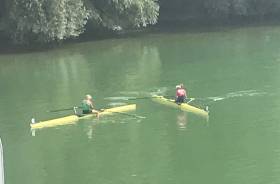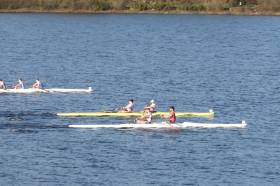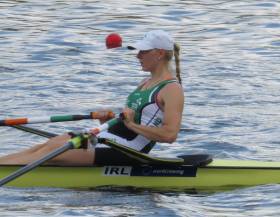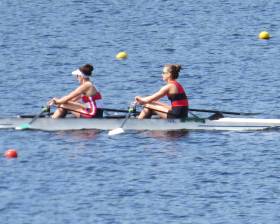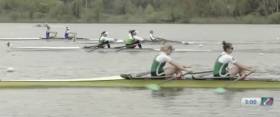Displaying items by tag: Puspure
Puspure Has Huge Margin as She Wins World Championship Quarter-Final
#Rowing: Sanita Puspure won the fastest quarter-final of the women's single sculls at the World Championships yesterday - with by far the biggest margin of victory. She had more than 15 seconds to spare over the 2012 Olympic champion Mirka Topinkova Knapkova of the Czech Republic.
Puspure became the third Ireland crew to go through to semi-finals in Olympic events in this Olympic qualification regatta.
World Rowing Championships, Linz-Ottensheim, Austria, Day Four (Irish interest)
Men
Double Sculls - Quarter-Final One - (First Three to A/B Semi-Finals; rest to C/D Semi-Finals): 1 Poland 6:15.06, 2 Ireland (P Doyle, R Byrne) 6:17.78, 3 Germany 6:21.04.
Lightweight Double Sculls - Quarter-Final Three - (First Three to A/B Semi-Finals; rest to C/D Semi-Finals): 1 Ireland (F McCarthy, P O'Donovan) 6:20.84, 2 Spain 6:22.84, 3 Poland 6:23.72.
Women
Pair - Quarter-Final Two (First Three to A/B Semi-Finals; rest to C/D Semi-Finals): 1 Australia 7:08.74, 2 Ireland (A Crowley, M Dukarska) 7:12.51, 3 Italy 7:13.11.
Lightweight Double Sculls - Quarter-Final Three - (First Three to A/B Semi-Finals; rest to C/D Semi-Finals): 4 Ireland (A Casey, D Walsh) 7:07.17.
Single Sculls - Quarter-Final Four - (First Three to A/B Semi-Finals; rest to C/D Semi-Finals): 1 Ireland (S Puspure) 7:21.03, 2 Czech Republic (M Topinkova Knapkova) 7:36.19, 3 Ukraine (D Dymchenko) 7:41.48.
Pararowing: Women's PR Two Single Sculls, Preliminary Race: 1 Australia (K Ross) 9:24.99; 3 Ireland (K O'Brien) 9:52.13.
Ireland Rowers On Pace but Out of Medals in Italy
#Rowing: Ireland crews contended in four A Finals on Sunday in the Memorial Paolo d’Aloja in Italy. There were two close-up fourth places: the lightweight men’s double of Jake McCarthy and Fintan McCarthy lost bronze to Portugal in the closing stages of their race, while the novel four of Tara Hanlon, Sanita Puspure, Aifric Keogh and Monika Dukarska fought to prevent a 1-2-3 of Romania crews in their race but missed out. The four of Claire Feerick, Emily Hegarty, Aileen Crowley and Claire Lambe were fifth.
Philip Doyle and Ronan Byrne were on the pace in the men’s double, but finished fifth, while Cliodna Nolan and Lydia Heaphy took sixth in the lightweight women’s double sculls.
Memorial Paolo d’Aloja, Piediluco, Italy, Finals (Irish results; selected)
Saturday
Men
Double – A Final: 3 P Doyle, R Byrne 6:33.90.
Lightweight Double Sculls – A Final: 3 F McCarthy, J McCarthy 6:38.43.
Women
Pair – A Final: 5 A Keogh, M Dukarska 7:33.3; 7 A Crowley, E Hegarty 7:42.36. B Final: 3 C Feerick, E Lambe 7:45.41.
Lightweight Double – A Final: 6 C Nolan, L Heaphy 7:48.91.
Single – A Final: 1 S Puspure 7:58.89.
Sunday
Men
Double Sculls – A Final: 5 P Doyle, R Byrne 6:41.56.
Lightweight Double Sculls – A Final: 4 F McCarthy, J McCarthy 6:45.55.
Women
Four – A Final: 4 T Hanlon, S Puspure, A Keogh, M Dukarska 7:05.53; 5 C Feerick, E Hegarty, A Crowley, E Lambe 7:06.98.
Lightweight Double Sculls – A Final: 6 C Nolan, L Heaphy 7:57.33.
Boomer and Crowley Pip O'Driscoll and O'Donovan at Ireland Trial
#Rowing: The new crew of Patrick Boomer and Fionnan Crowley beat Shane O’Driscoll and Mark O’Donovan in their second race of the day at the Ireland trial at the National Rowing Centre. Boomer, from Belfast Boat Club, and Castleconnell’s Crowley had just half a second to spare over the Skibbereen men.
The second session was run in bright sunshine and on good water. Chris Kirwan of St Michael’s and Grace Healy of Commercial were the top junior double – though racing from unfancied lane six. The men’s junior double was won by Andrew Sheehan of Lee and Aaron Keogh of Three Castles.
Denise Walsh and Aoife Casey, who may be the Ireland lightweight double for the season, looked impressive, while the under-23 four of Eimear Lambe, Claire Feerick, Emily Hegarty and Tara Hanlon also had a good win.
Sunday’s racing has been cancelled, because of a forecast of bad weather.
Ireland Trial, National Rowing Centre
Men
Pair: M O’Donovan, S O’Driscoll. Under-23: S O’Connell, A Goff
Jun Pair: S Daly/M Campion
Single Sculls
Lightweight: P O’Donovan. U-23 Lwt: M Taylor. Under-23: N Hull. Jun: J Kearney
Women
Pair: A Keogh, M Dukarska. Under-23: C O’Brien, K Shirlow. Jun: C O’Sullivan, J Duggan.
Single: S Puspure. Lightweight: D Walsh. U-23 Lwt: K Dolan. Jun: M Curry.
Second Session
Men
Pair: Boomer, Crowley
Four, Under-23: Goff, O’Connell, O’Rourke, Nolan
Four – Jun: Hume, Reidy, Allen, Siltanen.
Double – Lwt/U23: Sutton, Taylor. Jun: A Sheehan, A Keogh
Single – P O’Donovan. Jun: A Christie.
Women
Four – Lambe, Feerick, Hegarty, Hanlon. Jun: O’Donoghue, Tyther, McInerney, Murphy
Double – Walsh, Casey. Jun: C Kirwan, G Healy
Single: Puspure. (Jun/U23 lwt): K Dolan (u23), E Loftus.
Ireland in Three Finals at World Rowing Awards
#Rowing: Sanita Puspure, the O’Donovan brothers and Ireland lightweight coach Dominic Casey have all been chosen as finalists for the World Rowing Awards 2018. Puspure won gold in the women’s single sculls and Paul and Gary O’Donovan won the lightweight double, coached by Casey, at the World Rowing Championships.
Just two crews, along with Puspure, are in the running for Women’s Crew of the Year, while there are four crews in the finals of Men’s Crew of the Year and for Coach of the Year. Casey has reached the final three years in-a-row.
The awards will be presented on November 23rd in Berlin.
Finalists for the 2018 World Rowing Awards
Women’s Crew of the Year
- Caileigh Filmer, Hillary Janssens, Canada, Women’s pair
- Sanita Puspure, Ireland, Women’s single sculls
- Agnieszka Kobus-Zawojska, Marta Wieliczko, Maria Springwald, Katarzyna Zillmann, Poland, Women’s quadruple sculls
Men’s Crew of the Year
- Joshua Hicks, Spencer Turrin, Jack Hargreaves, Alexander Hill, Australia, Men’s four
- Jason Osborne, Germany, Lightweight men’s single sculls
- Johannes Weissenfeld, Felix Wimberger, Maximilian Planer, Torben Johannesen, Jakob Schneider, Malte Jakschik, Richard Schmidt, Hannes Ocik, Martin Sauer (coxswain), Germany, Men’s eight
- Paul O’Donovan, Gary O’Donovan, Ireland, Lightweight men’s double sculls
Para-rowing Crew of the Year
- Perle Bouge, France, Para PR2 women’s single sculls
- Ellen Buttrick, Grace Clough, Oliver Stanhope, Daniel Brown, Erin Wysocki-Jones (coxswain), Great Britain, Para PR3 mixed coxed four
- Annika van der Meer, Corne de Koning, Netherlands, Para PR2 mixed double sculls
Coach of the Year
- Uwe Bender, Germany, Men’s eight
- Dominic Casey, Ireland, Men’s pair, lightweight men’s and women’s double sculls, lightweight men’s quadruple sculls
- Jan Klerks, Netherlands, Para-rowing team
- Laurel Korholz, United States, Women’s four, women’s single sculls
2018 Sustainability Award
- “Pushing for a Clean Sweep”, National Schools Regatta, Great Britain
- “Partnership with Waikato Water Authority”, Rowing NZ, New Zealand
- “Love Where you Row”, Alan Robinson/Schuylkill Navy, United States
O'Donovan and O'Driscoll Win at Ireland Trial
#Rowing: Paul O’Donovan finished fifth overall in the single sculls at the Armada Cup, and Sanita Puspure third in the Gold Cup in Philadelphia, a race that was part of the Head of the Schuylkill event.
At the Ireland trial at the National Rowing Centre, Shane O’Driscoll and Mark O’Donovan won the men’s pair on Sunday, with David O’Malley and Shane Mulvaney second. O'Driscoll and O'Donovan did not compete on the Saturday.
Jack Dorney of Shandon won both the junior single sculls and the junior double, with Castleconnell’s Rory O’Neill. Molly Curry had equivalent wins: she teamed up with Lauren O’Brien – also of Castleconnell – on the Sunday.
UCD’s men’s senior eight were fastest at the Castleconnell Head of the River, and Enniskillen junior crews also shone.
Ireland Trial, National Rowing Centre (Provisional Results; winners) Saturday
Men
Pair - Senior: UCD (S Mulvaney, D O’Malley). Under-23: UCD (S O’Connell, A Goff).
Single - Senior: Shandon (A Harrington). Under-23: UCC (R Byrne)
Women
Pair: UCC, Skibbereen (A Keogh, E Hegarty). Under-23: Neptune, UCD (C Feerick, E Lambe). Jun: Cork Boat Club (C O’Sullivan, J Duggan).
Single – Sen: Killorglin (M Dukarska). Lightweight: Skibbereen (D Walsh). Under-23 Lightweight: Skibbereen (L Heaphy). Junior: Coleraine GS (M Curry).
Sunday
Men
Four – Under-23: O’Connell, Goff, Keating, Whittle. Jun 18: Gallagher, Daly, Butler, Murphy
Pair: M O’Donovan, S O’Driscoll
Double – Sen: Haugh, Crowley. Lightweight: J McCarthy, F McCarthy. Lwt U-23: Sutton, Gaffney Jun 18: Dorney, O’Neill.
Single – Sen: Byrne. U-23: Bann (Christie). Lightweight: Sutton.
Women
Four – Under-23: Hanlon, Casey, Lambe, Feerick. Jun 18: O’Sullivan, Duggan, Tyther, O’Donoghue.
Pair – Hegarty, Keogh. Jun 18: McGrath, Gannon
Double – Sen: Dukarska, Crowley. Lightweight: Walsh, Casey. Jun 18: Curry, L O’Brien.
Single – Lightweight: Legresley. U-23: Heaphy. Jun 18: Gilmore.
#Rowing: Sanita Puspure took second in her semi-final and qualified for the A Final of the single sculls at the World Cup regatta in Belgrade, Serbia. Denmark’s Fie-Udby Erichsen took over the lead early and won, with Puspure and Kara Kohler of the United States not far behind as they crossed halfway. However, the anticipated move from Vicky Thornley of Britain upset the order. She pushed up beside Puspure, who held on to second. Kohler missed out and finished fourth.
World Cup Regatta, Belgrade, Day Two (Irish interest)
Men
Pair – C Final (Places 13 to 18): 1 Hungary 6:55.35, 2 Greece 6:57.73, 3 Ireland (M O’Donovan, S O’Driscoll) 6:59.0, 4 South Africa 7:00.22.
Women
Pair – Semi-Final Two (Three to A Final; rest to B Final): 1 Spain 7:35.18, 2 Denmark 7:35.77, 3 Britain Two 7:39.35; 4 Ireland (A Keogh, E Hegarty) 7:42.60.
Double Sculls – Semi-Final (Three to A Final; rest to B Final): Netherlands 7:16.27, 2 Belarus One 7:18.73, 3 Belarus Two 7:23.46; 4 Ireland (A Crowley, M Dukarska) 7:25.60.
Single Sculls – Semi-Final (Three to A Final; rest to B Final): 1 Denmark (F Erichsen) 7:24.76, 2 Ireland (S Puspure) 7:25.43, 3 Britain (V Thornley) 7:25.78.
Ireland Rowing Team Chosen
#Rowing: The team which will represent Ireland at the World Cup in Belgrade (June 1st to 3rd) has been chosen. The selection was made after trials at the National Rowing Centre in Cork last weekend.
Belgrade is the first in a series of three World Cup regattas which culminate in the final World Cup in Lucerne from July 13th to 15th. This year, Rowing Ireland plans to send athletes to Belgrade and Lucerne.
In addition to the senior team competing in Belgrade, a training squad of athletes to be based at the National Rowing Centre in Cork has been announced.
Six rowers have also been selected to train for the Junior World Championships.
Ireland Team for World Cup Regatta, Belgrade, June 1st to 3rd:
Men
Pair: Mark O’Donovan, Shane O’Driscoll
Lightweight Double Sculls: Gary O’Donovan, Paul O’Donovan
Women
Pair: Emily Hegarty, Aifric Keogh
Double Sculls: Monika Dukarska, Aileen Crowley
Lightweight Double Sculls: Denise Walsh, Margaret Cremen
Single Scull – Sanita Puspure
Training Group to be based at National Rowing Centre:
Heavyweight Men: Andy Harrington, Patrick Boomer, Philip Doyle, Ronan Byrne.
Heavyweight Women: Tara Hanlon, Natalie Long.
Pre-Selected Rowers who will train for the Junior World Championships:
Men’s Quadruple: Jack Keating, Jack Dorney, Alex Byrne, Luke Nally-Hayes.
Women’s Double Scull: Ciara Moynihan and Ciara Browne.
Hot Competition at Ireland Rowing Trial
#Rowing: The standard was high at the second session of the Ireland Trial at the National Rowing Centre in Cork. Patrick Boomer and Andy Harrington again tested Shane O’Driscoll and Mark O’Donovan in the pair – this time the margin was just 1.3 seconds – and Sanita Puspure came in under seven minutes 40 seconds in another outstanding performance in the single sculls.
There was an all-Skibbereen shootout in the lightweight doubles: twins Jake and Fintan McCarthy, who are just 21, came in just 2.8 seconds behind Paul and Gary O’Donovan.
Margaret Cremen teamed up with Denise Walsh to produce a fast lightweight double, while Monika Dukarsa and Aileen Crowley formed a heavyweight double which also produced a good performance. Aifric Keogh and Emily Hegarty formed a pair which also bettered 90 per cent of projected world best time.
A second configuration of the men’s junior quad did very well, while the women’s junior double from Workmen’s again produced one of the best performances of the day.
Puspure and Dukarska Team Up to Take Sculling Bronze
#Rowing: Sanita Puspure and Monika Dukarska teamed up in a double to take a bronze medal at the Memorial Paolo d’Aloja in Italy today. The Ireland crew led early on and stayed in the mix as Lithuania took over the lead. In a dash for the line, Ireland and South Africa fought it out for silver, with the South Africans just taking it.
Ireland had earlier taken a medal in the single sculls through Emily Hegarty, who also took bronze.
Memorial Paolo d’Aloja International Regatta, Piediluco, Italy (Irish interest)
Sunday
Women
Double Sculls – A Final: 1 Lithuania 7:07.04, 2 South Africa 7:09.36, 3 Ireland (S Puspure, M Dukarska) 7:09.88.
Single Sculls – A Final: 1 Ukraine (D Dymchenko) 7:52.35, 2 Lithuania (L Saltyte) 8:11.90, 3 Ireland (E Hegarty) 8:14.76.
Crowley and Dukarska Win in Double in Italy
#Rowing: Ireland’s Monika Dukarska and Aileen Crowley took gold at the Memorial Paolo d’Aloja regatta in Piediluco in Italy this morning. The new double proved better than two Italian crews in a three-boat final. Sanita Puspure had to settle for silver in the women’s single, losing out to Diana Dymchenko of the Ukraine, while the women’s pair of Aifric Keogh and Emily Hegarty finished fifth in their six-boat final.
Memorial Paolo d’Aloja International Regatta, Piediluco, Italy (Irish interest)
Women
Pair – A Final: 5 Ireland (A Keogh, E Hegarty) 7:45.96.
Double Sculls – Final: 1 Ireland (M Dukarska, A Crowley) 7:13.93.
Single Sculls – A Final: 1 Ukraine (D Dymchenko) 7:38.04, 2 Ireland (S Puspure) 7:38.55, 3 Lithuania (M Valciukaite) 7:41.88.


























